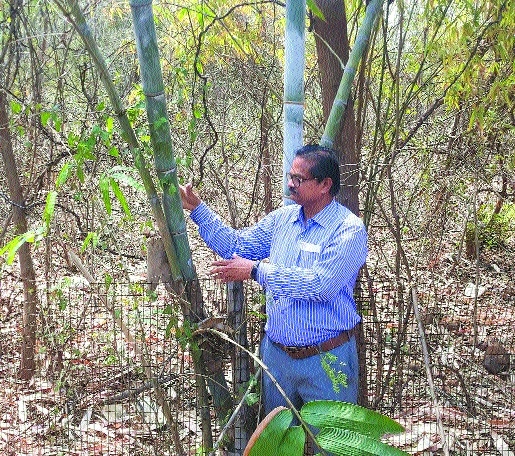Better mgmt can increase biomass production in 3 species of bamboo
| Date :11-Jul-2020 |

Dr V M Ilorkar inspecting gigabytes plantations at Agroforestry Research Farm on Amravati road.
By Ramesh Marulkar :
The research team of College of Agriculture, Nagpur, under Dr Panjabrao Deshmukh Krishi Vidyapeeth, Akola, conducting research on bamboo during the last six years observed that the biomass production of the three species – Balcoa, Katang, Stocksii – can further increase with better management and inputs like good fertile soil, appropriate level of fertilizers, irrigation and protection from fire, stray domestic animals and wild animals. It is expected that with better management the biomass can be increased by 1.5 times more. Almost 85 per cent area in the State is rainfed.
Irrigation is provided to orchards and cash crops on priority basis. Considering the available rainfed land in the region, the biomass estimation was carried out. The Cultivators can get financial benefits if the weight of bamboo is more. During research, the team also studied cost of production, including cost of establishment, maintenance for five years, harvesting charges etc (not included fencing, irrigation facility as it is not an essential component). The highest cost of production of Rs 94,228/- per hectare was recorded for Bamboosa bombose (Katang), followed by Balcoa – Rs 87,540/ha, Stocksii – Rs 76,889/ha and Tulda – Rs 75627/ha.
The lowest cost of Rs 40,354/ha was recorded for Multiplex species. Similarly, the team studied monetary return from all the species and derived benefit cost ratio. The rate of Rs 5,000/ton offered by Ballarshah Paper Mill was considered for calculations. Net monetary return of Rs 1,25,640/- was estimated for Balcoa, Rs 1,17,632/- for Katang and for Stocksii bamboo -Rs 1,03,932/- under rainfed condition. However, this monetary return may vary depending on inputs like fertile land, irrigation, fertigation and protection from fire, animals and trespassers. The highest benefit cost ratio of 2.44 was recorded for Balcoa, 2.34 for Stockssi and 2.25 for Katang, said Dr V M Ilorkar, Senior Scientist, Head of Agroforestry Research Farm and Principal Investigator, on Wednesday.
The single node culm cutting method is most useful because flowering of bamboo occurs after 25 to 40 years and some species even do not flower. In such species the single node culm cutting method is most useful. Dr Ilorkar said, these findings are most useful for upcoming bamboo based industries, banking system for approving the credit for bamboo cultivation. It is also useful to policy makers, farmers and academicians. Meanwhile, the world market for bamboo has been valued at Rs 50,000 crore in 2001 and is expected to grow to Rs 1,00,000 crore by 2025. India, China and Myanmar together have around 198 lakh ha of bamboo reserves – 80 per cent of the world’s bamboo forests.
Of this Indi’s share is about 45 per cent and only 4.5 per cent in global market. China alone has captured 50 per cent of the world market. The Agroforestry Research Centre had previously developed technologies for bamboo production, including application of circular trench method for soil water conservation, synthetic fertilizers for higher production, eco-friendly bamboo tree guards, developing root trainers, quality compost and animal fodder from bamboo leaves etc.
The College of Agriculture, Nagpur, established in 1906 is the oldest institution imparting agriculture education and it has been contributing significantly towards uplift of livelihood of farming community. Over the period the college has collected, planted and evaluated germplasm of crops, fruits, forest species, medicinal and aromatic plants. Dr Ilorkar and his team are carrying various agroforestry research activities at the farm under the guidance of Dr D M Panchbhai, Associate Dean of the college. (Concluded)